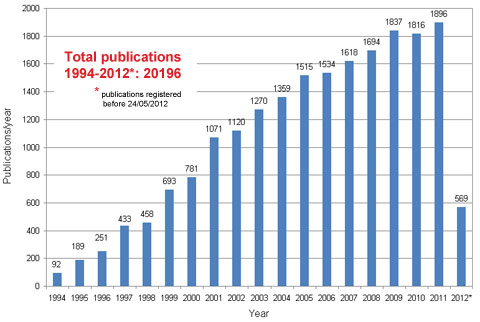- Home
- News
- General News
- 20,000 Publications...
20,000 Publications from ESRF Users and Staff
30-05-2012
Each experiment with synchrotron X-rays generates a world class publication.
Share
A milestone has been reached by users and staff of the ESRF: the cumulated number of publications in peer reviewed journals over the period 1994 to 2012 has passed the 20,000 mark. Francesco Sette, Director General of the ESRF, presented this figure and its evolution over time to the ESRF Science Advisory Committee (SAC) at its regular spring meeting on May 24, 2012.
Prof. K. Hämäläinen, Chairman of the SAC, congratulated everybody at the ESRF on behalf of the SAC on attaining this figure. He said, "This impressive figure testifies the importance and impact of the science carried out at the ESRF by a growing community of users coming from many disciplines, from both the countries of Europe and the rest of the world. No other synchrotron laboratory has achieved such high figures. I expect this growth to continue thanks to the big impact that the Upgrade Programme will have on the science of synchrotron radiation users working at the ESRF.”
 |
|
Publications in refereed journal from ESRF users and staff 1994-2012. |
Publications span a wide variety of science areas with regular breakthroughs in materials research, nanotechnology and pharmaceutical science. There are exceptional results even in the new fields of application of synchrotron X-rays such as archeological studies and cultural heritage. Many of the publications appear in journals with high impact factors such as Science and Nature – in 2011, one every two weeks on average. This reflects the quality of the research carried out by the ESRF’s users. It is also an indication of the involvement of the User Community in the continual development of the facility. The valuable feedback and appraisal of the facility by the User Community and its representatives permits the continual development of the experimental stations for future cutting-edge experiments.
The number of publications is an important benchmarking tool for every synchrotron facility. It is a measure of the productivity and of the success rate of the experiments carried out by the users. Users will typically have only a few experimental sessions per year at the ESRF, a very limited amount of time for them to complete their research before returning to their home institutes to interpret the X-ray data they collected at a beamline. Their success depends on the careful planning of experiments, support by staff at the beamlines, and the reliability of the X-ray source.
Top image: Examining a protein structure after data collection at the structural biology beamline ID23-1 (Credit: ESRF/Molyneux Associates).



